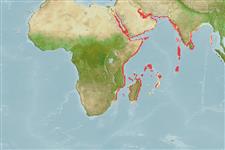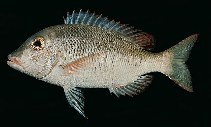Lethrinus borbonicus Valenciennes, 1830
Snubnose emperor
Ajouter votre observation dans Fish Watcher
| Native range | All suitable habitat | Point map | Year 2050 |

|
| This map was computer-generated and has not yet been reviewed. |
| Lethrinus borbonicus AquaMaps Data sources: GBIF OBIS |
Envoyez vos Photos et vidéos
Pictures | Images GoogleLethrinus borbonicus
Picture by Randall, J.E.
Pictures | Images GoogleLethrinus borbonicus
Picture by Randall, J.E.
Saudi Arabia country information
Common names:
[No common name]
Occurrence: native
Salinity: marine
Abundance: | Ref:
Importance: minor commercial | Ref: Carpenter, K.E. and G.R. Allen, 1989
Aquaculture: | Ref:
Regulations: | Ref:
Uses: no uses
Comments:
National Checklist:
Country Information: https://www.cia.gov/library/publications/resources/the-world-factbook/geos/sa.html
National Fisheries Authority:
Occurrences: Occurrences Point map
Main Ref: Carpenter, K.E. and G.R. Allen, 1989
National Database:
Occurrence: native
Salinity: marine
Abundance: | Ref:
Importance: minor commercial | Ref: Carpenter, K.E. and G.R. Allen, 1989
Aquaculture: | Ref:
Regulations: | Ref:
Uses: no uses
Comments:
National Checklist:
Country Information: https://www.cia.gov/library/publications/resources/the-world-factbook/geos/sa.html
National Fisheries Authority:
Occurrences: Occurrences Point map
Main Ref: Carpenter, K.E. and G.R. Allen, 1989
National Database:
Common names from other countries
Classification / Names Noms communs | Synonymes | Catalog of Fishes(Genre, Espèce) | ITIS | CoL | WoRMS | Cloffa
> Eupercaria/misc (Various families in series Eupercaria) > Lethrinidae (Emperors or scavengers) > Lethrininae
Etymology: Lethrinus: Greek, lethrinia, a fish pertaining to genus Pagellus.
More on author: Valenciennes.
Etymology: Lethrinus: Greek, lethrinia, a fish pertaining to genus Pagellus.
More on author: Valenciennes.
Environment: milieu / climate zone / depth range / distribution range Écologie
marin récifal; non migrateur; profondeur ? - 40 m (Ref. 9710). Tropical; 30°N - 30°S, 33°E - 93°E
Distribution Pays | Zones FAO | Écosystèmes | Occurrences | Point map | Introductions | Faunafri
Indian Ocean: including the Red Sea and the Persian Gulf south to Durban, South Africa, then east to North Bay Reef, Andaman and Nicobar Islands. Reports of this species elsewhere are probably due to misidentification.
Length at first maturity / Taille / Poids / Âge
Maturity: Lm 21.3 range ? - ? cm
Max length : 40.0 cm TL mâle / non sexé; (Ref. 2295); common length : 25.0 cm TL mâle / non sexé; (Ref. 2295)
Max length : 40.0 cm TL mâle / non sexé; (Ref. 2295); common length : 25.0 cm TL mâle / non sexé; (Ref. 2295)
Description synthétique Clés d'identification | Morphologie | Morphométrie
Épines dorsales (Total) : 10; Rayons mous dorsaux (Total) : 9; Épines anales: 3; Rayons mous anaux: 8. The inner surface of the pectoral fin base is densely scaled; posterior angle of the operculum is fully scaled; cheeks without scales. Color of body is dark gray or yellow-brown, head is brown-gray. The centers of scales are lighter. Sometimes there is an irregular pattern of broken dusky bars becoming whitish on the lower part of the body. The pectoral and pelvic fins are white of pinkish. The dorsal and anal fins are mottled white or yellowish with reddish edge. The caudal fin has indistinct reddish bands.
Found in sandy areas near reefs during daytime, sometimes in small groups. At night, they are solitary and range over reef-flats and slopes where they feed primarily on echinoderms, mollusks and crustaceans (Ref. 2295). The taxonomy of this species has been considerably confused.
Life cycle and mating behavior Maturité | Reproduction | Frai | Œufs | Fécondité | Larves
Exhibits juvenile hermaphroditism (Ref. 107020).
Référence principale
Upload your references | Références | Coordinateur | Collaborateurs
Carpenter, K.E. and G.R. Allen, 1989. FAO Species Catalogue. Vol. 9. Emperor fishes and large-eye breams of the world (family Lethrinidae). An annotated and illustrated catalogue of lethrinid species known to date. FAO Fish. Synop. 125(9):118 p. Rome: FAO. (Ref. 2295)
Statut dans la liste rouge de l'IUCN (Ref. 130435: Version 2024-2)
Préoccupation mineure (LC) ; Date assessed: 28 June 2018
Menace pour l'homme
Harmless
Utilisations par l'homme
Pêcheries: intérêt commercial mineur
FAO(pêcheries: production; publication : search) | FishSource | Sea Around Us
Plus d'informations
Trophic ecology
Éléments du régime alimentaire
Composition du régime alimentaire
Consommation alimentaire
Food rations
Prédateurs
Éléments du régime alimentaire
Composition du régime alimentaire
Consommation alimentaire
Food rations
Prédateurs
Population dynamics
Paramètres de croissance
Max. ages / sizes
Length-weight rel.
Length-length rel.
Fréquences de longueurs
Mass conversion
Recrutement
Abondance
Paramètres de croissance
Max. ages / sizes
Length-weight rel.
Length-length rel.
Fréquences de longueurs
Mass conversion
Recrutement
Abondance
Life cycle
Reproduction
Maturité
Fécondité
Frai
Spawning aggregations
Œufs
Développement de l'œuf
Larves
Dynamique des populations larvaires
Reproduction
Maturité
Fécondité
Frai
Spawning aggregations
Œufs
Développement de l'œuf
Larves
Dynamique des populations larvaires
Anatomy
Surface branchiale
Brain
Otolith
Surface branchiale
Brain
Otolith
Physiology
Body composition
Nutrients
Consommation d'oxygène
Type de nage
Vitesse de nage
Visual pigments
Fish sound
Diseases & Parasites
Toxicity (LC50s)
Body composition
Nutrients
Consommation d'oxygène
Type de nage
Vitesse de nage
Visual pigments
Fish sound
Diseases & Parasites
Toxicity (LC50s)
Genetics
Génétique
Heterozygosity
Héritabilité
Génétique
Heterozygosity
Héritabilité
Human related
Aquaculture systems
Profils d'aquaculture
Souches
Ciguatera cases
Stamps, coins, misc.
Aquaculture systems
Profils d'aquaculture
Souches
Ciguatera cases
Stamps, coins, misc.
Outils
E-book | Guide de terrain | Générateur de fréquences de longueur | Outil de dynamique de population | Carte par point | Classification Tree
| Catch-MSY |
Articles particuliers
Télécharger en XML
Sources Internet
Aquatic Commons | BHL | Cloffa | Websites from users | FishWatcher | CISTI | Catalog of Fishes(Genre, Espèce) | DiscoverLife | ECOTOX | Faunafri | Fishtrace | GenBank(génôme, nucléotide) | GloBI | GOBASE | | Google Books | Google Scholar | Google | IGFA World Record | MitoFish | Otolith Atlas of Taiwan Fishes | PubMed | Reef Life Survey | Scirus | SeaLifeBase | Arbre de Vie | Wikipedia(aller à, chercher) | World Records Freshwater Fishing | Zoobank | Zoological Record
Estimates based on models
Preferred temperature (Ref. 115969): 25.5 - 29.2, mean 27.2 (based on 250 cells).
Phylogenetic diversity index (Ref. 82804): PD50 = 0.5000 [Uniqueness, from 0.5 = low to 2.0 = high].
Bayesian length-weight: a=0.01318 (0.00813 - 0.02137), b=3.03 (2.89 - 3.17), in cm Total Length, based on LWR estimates for this species & Genus-body shape (Ref. 93245).
Niveau trophique (Ref. 69278): 3.5 ±0.41 se; based on food items.
Résilience (Ref. 120179): Haut, temps minimum de doublement de population inférieur à 15 mois (Preliminary K or Fecundity.).
Fishing Vulnerability (Ref. 59153): Low vulnerability (23 of 100).
Climate Vulnerability (Ref. 125649): High to very high vulnerability (68 of 100).




